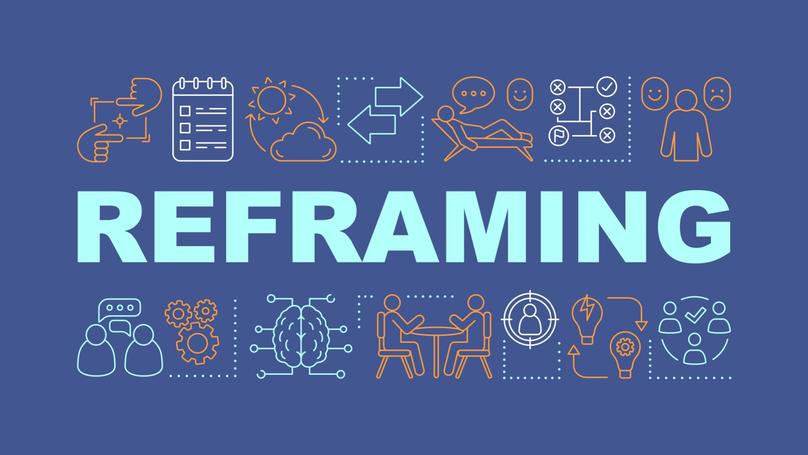Reframing

What is reframing?
Reframing is a special technique that enables you to rethink and restructure the mechanisms of perception, thinking, and behaviour in order to change someone else's or your own point of view or belief about something. To put it simply, using this approach will enable you to view things from a different angle, see the bright side of things even in the most dire circumstances, and make a competent and informed decision.
At the same time, reframing does not imply achieving a result by deception, cunning, or pretence. The method must only be applied within the confines of truth, reasonable human conceptions of something, and the real picture of the world in order for the effect to be the longest-lasting and fruitful.
The term "reframing" comes from the English word "frame". We view our entire life experience through a certain "framework", in which some events, ideas, thoughts come to the fore and the rest stay in the background. By literally moving your experience into a different frame and reconsidering it, you can see what is hidden beneath the surface and go beyond conventional thinking and our artificial limitations.
So, every individual has a unique perspective on the same event. For example, two employees were sent to classes to hone their skills and cultivate leadership thinking as part of corporate training. While one of them views this as a great chance to advance professionally and further their career, the other will think it's a pointless activity and a waste of time. Depending on how the employees feel about taking classes, the final result will change. Using reframing, you can convince an employee who does not want to take a course that it will be interesting and helpful for their career. After all, Bernard Shaw, an Irish playwright, once said, "Both optimists and pessimists contribute to society. The optimist invents the aeroplane, the pessimist the parachute."
Types of reframing
Reframing can be done in a few simple ways. Depending on what you choose, the key types are as follows:
-
Context reframing
This type of approach entails adjusting the dimensions of our frame of perception. We need to enlarge the frame, or on the other hand, constrict it, in order to contextualise a particular event, phenomenon, or idea. This enables us to view the situation in a different light and perceive what was previously outside the frame and, thus, out of our field of vision. You can extend the time period in this way. If, for instance, you feel that you wasted your time and effort on work that ultimately proved to be pointless, these advancements might prove useful in the future, and your enhanced ability will be highly beneficial in this endeavour!
Comparison offers yet another way to broaden the frame of reference. You can, for instance, contrast your current self with your previous self in terms of knowledge and abilities. If you're concerned that you're devoting too much time and energy to a certain task, keep in mind that even more resources were dedicated to it only a few months ago.
-
Reframing the content or meaning
Simply put, it is a change in your attitude towards a particular situation. Look for the good things and advantages that pertain to you specifically in any negative events. We could say that we place a particular image-that is, a circumstance, phenomenon, or viewpoint-into a more appealing or neutral frame. For instance, implementing new technologies in a business takes a significant amount of time, energy, and material resources. Simultaneously, this will guarantee the business's expansion, profitability, and future development.
Reframing works wonders in interpersonal relationships as well. There is a simple formula to reframe content: an expression with a more positive meaning should be used in place of the evaluative word or phrase. The phrase "inexperienced employee" would instantly have a completely different meaning if it were to be substituted with "young and ambitious specialist ready for training," for example. The conjunction "but" is also used in another formula: you made a mistake, but you now you know exactly what not to do; the work is extremely stressful, but it will help you improve your professional skills and advance in your career; he's not nice to talk to, but he's a true professional and you can learn a lot from him.
-
Group reframing
This technique is mainly employed to alter an individual's interpretation of an event, redirect their focus from concerns to solving a problem, or entirely eliminate anxiety related to a particular matter. Group reframing can be of two types:
-
Disconnection reframing - here, the issue, circumstance, and unsettling notion are broken down into smaller components, and the person's focus shifts from general concerns to the necessary steps to address the situation;
-
Association reframing - this, on the hand, is a mental process that involves shifting from the specifics of a situation to the big picture of what transpired. At that point, the issue will start to appear less personal and more abstract. Association reframing phrases include things like "It could have been worse," "This could happen to anyone," and "Actually, it's not that bad."
Reframing in NLP

The concept of reframing first appeared in NLP. Neurolinguistics defines reframing as a special concept used to create a specific focus or emphasis in the perception of a new experience. Changing the meaning of an event and looking at it from a new perspective is the task of reframing.
Let us recall that neurolinguistic programming is an approach to interpersonal communication, self-improvement, and personal growth that enables you to alter your behavioural patterns and succeed in nearly any endeavour. NLP was developed back in the 1970s, and its founders are considered to be linguist John Grinder and psychologist Richard Bandler. Advocates of this method believe that the body's neurological processes, language, and behavioural patterns are closely related, and that these relationships can be influenced using special techniques in order to accomplish goals.
In NLP, reframing is studied primarily from the perspective of the context in which an individual perceives information. Here's a simple example to illustrate the significance of frames in our lives: you had an important business meeting coming up. Suddenly, the person with whom it was supposed to happen-your investor, partner, or whatever-reschedules. It now all depends on how you respond: with furious indignation, annoyance, or acceptance. Your explanation of the meeting's cancellation to yourself, or the frame, will have an impact on this.
NLP recognises various primary and most common frames of perception in total. These include:
-
Environmental frame
It entails considering long-term effects and evaluating an event's or phenomenon's influence beyond the usual time and space boundaries. Put another way, someone who intentionally (or unintentionally) creates an environmental frame around a specific circumstance discusses how the event has affected not only themselves but also those who are close to them, their interests, and daily life. Furthermore, the environmental frame includes an analysis of the outcomes that could have occurred, as well as the implications for every aspect of life that they might have an impact on.
To create an environmental frame for the situation, one should envision multiple scenarios for how the events might progress. After that, one must return to the present moment and evaluate the situation from a completely new angle. Here are some questions to help you build an environmental frame:
-
"What happens if I do this?";
-
"Who will be affected by my decision?";
-
"What areas of life will this incident affect, and how can it change them?".
-
Result frame
When using this frame, a person focuses mainly on whether a particular event, phenomenon, concept, and its consequences will help them get closer to achieving their goal. As a result, before taking any particular action, one must impartially assess and analyse its efficacy and efficiency in order to create a result frame around the event. The following questions help them with this:
-
"Will this step bring me closer to my desired result?";
-
"What advantage will I get by deciding to take a certain action?";
-
"Are there other options to achieve my goal faster?".
-
"What if…?" frame
It entails evaluating situations and phenomena based on a range of presumptions and educated guesses about possible outcomes. With the help of this kind of frame, new facets of the same event can be found and thoughtfully assessed.
For example, when thinking about something that is about to happen, try to immediately imagine the result of your decision. Then analyse it, balance its advantages and potential drawbacks, and give an overall assessment. You will notice many subtleties and details of the situation that you were previously unaware of after completing this exercise. Moreover, using the "What if...?" frame allows you to develop intuition and insight.
The main question that will help assess what is happening using such a frame is reflected in its name. Other supporting phrases may include:
-
"Assume that...";
-
"Suppose I decide to do this...";
-
"What might happen if...?".
-
Relationship frame
Because it depicts the analysis of events based on their relationships and influences on one another, it is frequently referred to as a system frame. As you know, a system is made up of a number of interrelated parts that work together closely to create unity and integrity. That's why you should use the system frame to figure out exactly what has happened or is going to happen.
Instead of concentrating on a single incident that occurred, you should consider how it relates to other phenomena. It is possible to find recurring themes and distinctive connections between events in this way. This will remove obstacles and mitigate possible risks when planning the next step or decision. The following questions can help you start thinking using the relationship frame:
-
"How are these events related to each other?";
-
"What can stop this from happening?";
-
"What, on the contrary, contributed to this event?";
-
"What is the relationship between these two factors?".
-
Negotiation frame
When constructing such a frame, events must only be evaluated in terms of whether they will enable a person to come to an understanding and agreement with the other party.
Therefore, when engaging in communication with someone, be it a business partner, investor, or significant other, you should know what terms of engagement will be advantageous to both parties. This will enable you to reach a resolution to a problem and obtain what you both require. Use these questions to accomplish this:
-
"What compromise can we find in this case?";
-
"What will suit both me and you?";
-
"What could you concede on, and what could I concede on?";
-
"What are we both okay with?".
A person's frame of reference influences not only how they interpret information but also how they will respond to it and act going forward.
Regardless, the reframing process entails providing a new context for the situation. This kind of reconsideration and alteration of the typical mechanisms of perception and thought will aid in preventing the formation of specific behavioural patterns and cognitive distortions. Furthermore, from an NLP perspective, there are advantageous resources in every circumstance; it's critical to learn how to identify and take advantage of them for your own purposes.
Reframing in advertising and sales

Marketing and sales are two domains where reframing is actively used. You have undoubtedly noticed how, with the help of marketing campaigns, companies allay consumers' concerns and transform the drawbacks of their goods into benefits that make them unquestionably worthwhile purchases.
Thus, reframing a product or service involves putting it in a particular context, encouraging the customer to view it from a different perspective, presenting it in a more positive light, and avoiding drawing attention to any flaws or shortcomings that may already be present. In conclusion, reframing enables you to:
-
Show the customer a particular offer from the side that benefits you the most;
-
Hide the slightest imperfections;
-
Convince the customer of the need to purchase a product or use the service you offer;
-
Prove the customer's objections unfounded.
Reframing may appear simple to use at first because, after all, what could be simpler for a seasoned salesperson than persuading a customer to buy something? But in order to reframe as effectively as possible and get results quickly, you need to follow a few basic rules:
Rule №1. Always agree with the person you are talking to
Don't even try to refute the customer's beliefs, have an argument, or show that you are correct. Quite the opposite-you must persuade the customer that you are on their side, that you understand their needs and desires, that you share their pain, and that you want to assist in resolving the issue. Quarrels and disagreements will only make the situation worse. The result of disagreements is usually that no one is persuaded.
That is why you need to build a dialogue with the consumer so that they feel secure in their ability to make decisions on their own and independently arrive at conclusions that benefit you. In this situation, you should respond to the customer's objections with empathy by saying something like, "Yes, I understand you," or "I also had to deal with similar things." Stated differently, you shouldn't "attack" the customer with a big offer; instead, you should act smarter and let them persuade themselves through their own reasoning.
Rule №2. Strive for reciprocal agreement
You should proceed to questions that the other person can no longer dispute once you have demonstrated your understanding of the customer's circumstances and your willingness to assist them in finding solutions. You must phrase them so that the other person responds in the affirmative. For example, "Is product quality important to you?" or "What is more important to you - free delivery or high quality?" or "Would you like your equipment to serve you for many years?"
So, the main goal is to avoid receiving a negative response. By doing this, you'll be able to start subconscious processes in the customer's mind that will encourage them to decide in favour of buying your product or service.
Rule №3. Overcome your customer's objections by offering them products they can't refuse
It's time to deal with the customer's disagreements and objections now. You should switch to your product once they are persuaded that you understand their needs and desires and that you generally agree with them. Explain its benefits while keeping in mind the customer's previously determined interests. There are different suggestions for carrying on the conversation. For example:
-
do not interrupt the customer and let them speak;
-
try to avoid discussions so as not to turn the customer against you;
-
put off discussing the price of the product;
-
listen carefully to the customer's objections and find among them those minor points that you agree with;
-
make a list of possible objections to a particular product in advance and prepare to respond to them (just don't stick to predetermined speech patterns);
-
avoiding disputes, never tell the customer that they are wrong;
-
be optimistic and friendly in your interactions.
Ask your customer to meet again so you can continue the conversation at a later time if you were unable to their trust during the initial exchange. For example, you can contact the customer to inform them about ongoing promotions and the arrival of new products.
The main mistakes made when using reframing in marketing, which can prevent the development of a trustworthy relationship with the customer, are:
-
insufficient understanding of their needs, that is, the use of reframing without taking into account the interests and desires of the customer;
-
coercion and pressure (remember that reframing is not a way to force someone to agree with you);
-
reframing without evidence, that is, an attempt to change the customer's perception of a particular product without sufficient explanation or demonstration of accurate data that can be trusted;
-
ignoring the reaction; it is necessary to keep an eye on how the customer reacts to the reframing used, modifying this technique depending on their feedback.
Reframing is therefore referred to as both simple and complex to use in marketing. However, reframing is a very simple and powerful technique. Sure, it can be challenging to apply it organically and naturally during customer negotiations. Nevertheless, by avoiding these typical errors, reframing-which highlights the value of a product or service-can be a powerful tool for boosting sales.
Six-step reframing

This is the term for a unique template created by NLP experts, which is based on the idea that people's thoughts and actions are not under their conscious control. Furthermore, the six-step reframing theory suggests that any issue or disagreement can be settled with just six easy steps. As a result, this method is also known as universal. It is divided into the following stages:
Step 1: Formulating the issue
In other words, this stage involves recognising and labelling thought patterns or behaviours that a person would like to change, a dispute that needs to be settled, or a specific issue. Simultaneously, it's critical to identify and express what doesn't work for you. Next, write a letter or number next to the same behaviour that doesn't work for you. For instance, X, N, or 7. Words that are familiar to us-such as alienation, rage, arrogance, and indifference-already involve judgment and are applied negatively. This may prevent further reframing. Thus, neutral definitions should be used in place of words to eliminate evaluativeness.
Step 2: Establishing contact
The next step is to make a connection with the aspect of yourself, your Self, that is in charge of a particular behaviour and the reason you behave in that particular way rather than a different one. You come into contact with your own personality just like you do with people. Thus, for example, you should say that you would like to talk to the part of yourself that is in charge of behaviour X. Next, you need to determine the key "Yes" and "No" signals. Consider which of your responses will be indicative of a positive and which of a negative reaction. This could mean squinting the eyelids, changing your breathing, or moving your fingers, head, or legs. Now more than ever, pay attention to what your body is telling you.
Step 3: Determining intent
The contact with the behaviourally-driven portion of the subconscious continues. Finding out what its intentions are is crucial. It is true that the subconscious can communicate its intentions to you, but it can only do so through images or feelings. It's critical that you understand it correctly and pay attention to what your body is telling you. By doing this, you might be able to come up with an alternative solution for a particular issue while also considering the good intentions of your subconscious.
Step 4: Identifying new behaviour strategies
At this point, the creative part of our subconscious is awakened, which is capable of inventing and creating new things, like new forms of behaviour. Once more, you ask the subconscious and your creative self to provide new strategies for behaviour and thinking. Selecting those that outperform the X identified at the first stage in terms of effectiveness and efficiency is crucial.
Step 5: Checking
This is the most important step - you need to determine whether the individual can be harmed by new behavioural patterns. You can accomplish this by creating connections between parts of the subconscious and asking the one causing the undesirable behaviour to behave in a different way.
Next, you should inquire about any aspects of the personality, such as the creative side, that are opposed to particular behaviour options. You can proceed and go on to the next step if there are no such aspects, that is, if the "No" signal is not detected. If you notice the "Yes" signal, you should go back to the previous stage and search for more subconsciously acceptable patterns of behaviour.
Step 6: Taking responsibility
Just because you have identified more effective behaviours than X does not guarantee that your subconscious mind will use them. We all know, for instance, how beneficial exercise is in the morning. But you must admit, not many people truly follow through on it. As a result, at the final stage, it's critical to agree with the subconscious part that is responsible for behaviour and ask whether it is ready to take responsibility for employing these new, more efficient, and successful tactics. A "No" signal to the key question may mean that you missed the earlier stage's subconscious mind's resistance to the new behaviour patterns. Or the part responsible for behaviour is afraid of not being able to cope with the task. Then you should encourage it to try new tactics for a week or a month. If the results are positive, you should either stick with the original strategies or select new ones using the six-step reframing technique again.
Thus, the six-step reframing technique will enable you to alter not just your perspective on a given circumstance or issue, but also your actions in specific scenarios. By employing this method, you will subconsciously alter your thought and behaviour patterns to ones that are more practical and productive for you. Many seek the help of hypnologists and hypnotherapists in order to get better results. These professionals conduct therapy sessions and literally communicate with the client's subconscious using the same six-step scheme. However, you can practice such reframing yourself. The most important thing is to pay close attention to the smallest details, listen intently to your body's reactions, and then keep an eye on how you are responding to different situations.
Examples of reframing
Reframing can (and should!) be used in everyday life. For example, it is especially effective in business relationships. Suppose an informal leader appears in your team. You can treat them differently: see them as a potential assistant and your right hand, or as a competitor and rival. So, if you believe that an informal leader is dangerous because they have power over their colleagues, can influence them and yet not bear any responsibility, use the reframing technique. Using content reframing, change your attitude towards the situation and place it in a different frame. The benefits of having an informal leader will then become apparent to you, such as assisting the group in reaching objectives and fostering and strengthening team spirit.
Let's have a look at another example. Undoubtedly, a lot of people have been in similar circumstances: you enjoy being creative and doing creative work, but you are now required to perform routine analytical tasks. What possible advantages could there be? Well, we use context reframing and the situation changes. A professional should actually be able to perform any task, not just ones that they enjoy. Furthermore, the secret to a successful career is having a versatile set of skills and abilities. In this manner, you will be convinced that your efforts, even on the tasks you dislike, are not in vain.
Another situation: you get a good job at a big company. The only downside (at first glance!) is that you have to travel a lot for work. You might not be happy at first, but try to see things from a different perspective. First of all, it's a chance to travel, make new friends, and take a break from your usual routine. You can also earn more and do things that you usually didn't have time for, like read a book or watch a film or a TV show.
Having to speak in front of an audience at a conference or symposium is another typical example. Nothing could be worse for someone who is terrified to speak in front of an audience. Reframing helps to solve the problem. Discover the advantages even public speeches have. Speaking at a conference, for instance, or any other event of a similar nature, will always look good on your resume and is undoubtedly necessary for professional advancement. Additionally, it's a chance to showcase your best qualities to a wide range of people, including prospective employers, experienced colleagues, interested business partners, and investors.
Conclusion
Thus, reframing is an excellent strategy for changing your own behavioural and thinking patterns. It is simple and effective to use, and at the same time absolutely universal. Reframing is applicable to all areas of activity and interpersonal relationships. By using this approach, you'll be able to broaden your horizons, learn to see the positive side of everything, learn to take advantage of every opportunity, and stop putting boundaries on your own life.























